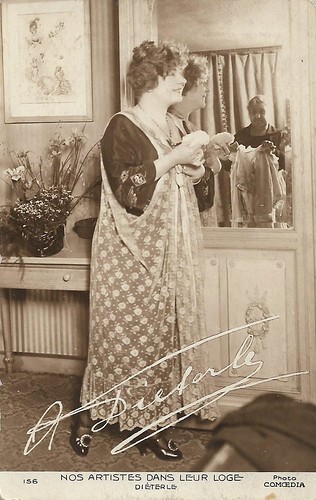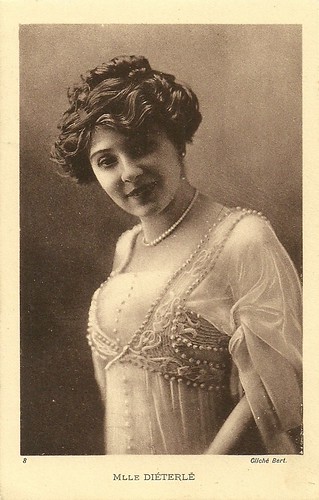
French postcard by S.I.P., no. 1208. Photo: Reutlinger, Paris. Caption: [Park of] St. Cloud, Paris. Mailed in 1901.

French postcard in the 'Nos artistes dans leur loge' series, no. 156. Photo: Comoedia, Paris.

French postcard by S.I.P., no. 439, series 10. Photo: Reutlinger, Paris.

French postcard by S.I.P., no. 186/1. Photo: Reutlinger, Paris. Caption: Variétés. Postcard mailed in 1904.

French postcard by S.I.P., no. 138, series 11. Photo: Reutlinger, Paris. Caption: Bouffes-Parisiens. Postcard mailed in 1904.
The toast of the town in Paris
Amélie Diéterle was born in Strasbourg as the first child of the maid Dorothée Catherine Dieterle and French officer Louis Alexis Laurent. Her father stayed in a garrison near Munich in 1870 and Strasbourg in 1871, and it was not until 1892 that he recognised her as his child when he officially married his wife, but Amélie kept her mother's name as stage name. The family moved to Dijon, where Diéterle entered the local conservatoire in 1885. In 1888, tragedy struck, when her brother Ernest drowned in one of the sand pits on the outskirts of town.
In 1890, the family moved to Paris, where Amélie received the first prize for singing and solfège at the Dijon Conservatoire. In 1891, she joined the Théatre des Variétés, where she stayed until 1925. In 1898 she went on tour to Moscow and St Petersburg, where she sang Breton, Provençal and Dutch songs. During her trip, she also visited Brussels and Berlin.
Her patron was the theatre owner Paul Gallimard. Later she became his mistress too. He left his wife and children, among whom the famous future editor Gaston, and installed Amélie in an apartment at the chic Boulevard des Malesherbes.
In 1901, Diéterle bought land in Croissy-sur-Seine, on which, in keeping with the fashion of the time, she built a beautiful villa with the look of an English cottage. It was named Villa Omphale, after one of her great roles, Omphale in 'Les Travaux d'Hercule' by de Flers & Cavaillet, performed at the Bouffes-Parisiens. The success of this play and subsequent spectacles earned her laurels too and she became Officier d'académie. Specialised in song and dance, In 1904, Diéterle went to Argentina, Uruguay and Brazil for a successful four-month Latin-American tour.
Diéterlé became the toast of the town in Paris, performing in high society. She also became the muse of painters such as Renoir, Vallotton, Toulouse-Lautrec and Roll. She had a massive art collection of Realist and Impressionist paintings. She was also one the most photographed artists, recorded by Paul Nadar, Paul Boyer, Leopold Reutlinger, Henri Manuel, and others, resulting in countless postcards with her portrait, often showcasing her taste in elegant costumes. In 1908 she was again awarded, now as Officier de l'instruction publique, which raised critique on Diéterle, Gallimard and the awarding minister Doumergue. Another public success Diéterle had in 'Le Roi' by De Flers & Caillavet. It was performed 530 times in 1908 and 1909.

French postcard by S.I.P., no. 910, series 8. Photo: Reutlinger, Paris. Card mailed in 1905.

French postcard by S.I.P., no. 1801, series 34. Photo: Reutlinger, Paris. Postcard mailed in 1903.

French postcard by S.I.P., no. 17, series 42. Photo: Reutlinger, Paris. Card mailed in 1902.

French postcard by S.I.P., no. 11, series 50. Photo: Reutlinger, Paris.

French postcard. S.I.P., no. 5, series 53. Photo: Reutlinger, Paris.

French postcard by S.I.P., no. 1323. Photo: Reutlinger, Paris.
Passionate about cinema
Amélie Diéterle was passionate about cinema. In 1909, she started an additional career in film. In the drama Le Luthier de Cremône/The Violin Maker of Cremona (Albert Capellani, 1909), she co-starred with Jean Dax. He played a hunchback, a highly talented violin player who sacrifices himself for the well-being of the woman (Diéterle) he secretly loves but who loves another man. This may well have been her film debut. Another drama was Le mort vivant/The Living Dead (Michel Carré, 1911) with Paul Numa.
She acted in many comedies most often in the Rigadin comedies with Charles Prince, produced by Pathé Frères and directed by Georges Monca. Examples are Rigadin cambrioleur/Rigadin Burglar (Georges Monca, 1911) and Le ménage de Rigadin/Rigadin's Household (Georges Monca, 1912). In addition to the Rigadin comedies, Diéterle played Mimi Pinson in the Alfred de Musset adaptation Miss Pinson (Georges Monca, 1910). All in all, Diéterle acted in 25 shorts between 1909 and 1913.
Meeting aviation pioneers Robert Martinet et Georges Legagneux in 1911, Diéterle made her first trip on a plane, accompanied by Gallimard and actors and actresses of the Théatre des Variétés. This was at a time when flying was a dangerous hazard and indeed Legagneux would crash during a flight show in 1914 while Martinet would die with his plane during the First World War in 1917. During the First World War, Dieterle worked as a nurse. In 1917 she retook her work at the Théatre des Variétés. In that year, she also performed in Spain at the Teatro Reina Victoria in Madrid.
In 1919 Diéterle was involved in an affair around fake Rodin statues, made by his former assistants soon after his death. Although not proven guilty, Gallimard and Diéterle were accused of involvement. Moreover, the press spelt Gallimard and Diéterle's extramarital affair, so she separated from Gallimard and gradually retreated from the stage.
In 1927, after the couple who guarded her villa had bestolen her in her absence, she had a property built on the Route Nationale at Golf-Juan in the municipality of Vallauris in the Alpes-Maritimes department. The villa in Greek style was named 'Omphale', just like her previous villa. In 1930, at Vallauris, Diéterle married André Louis Simon, financier and founder of the Monoprix in Nice. In 1933 she sold a large part of her art collection. During the Second World War, Amélie Diéterle retreated to an apartment in Cannes, where she died on 20 January 1941, at the age of 70, after a long illness.

French postcard by Atterocca, Terni, no. 2080. Photo: Paul Boyer, Paris. Card mailed in 1904.

French postcard by ND Phot., no. 3.2. Photo: Henri Manuel, Paris. Caption: Bouffes-Parisiens. Postcard mailed in 1907.

French postcard by S.W., no. 0421. Photo: Reutlinger, Paris. Card mailed in 1906. Amélie Diéterle as Queen Omphale in the 'opera bouffe' 'Les Travaux d'Hercule' (The Works of Hercules, 1901) by Gaston-Arman de Caillavet and Robert de Flers, on music by Claude Terrasse, performed at the Bouffes-Parisiens.

French postcard by Papier Guilleminot, series 771, Th 72. Photo: Stebbing, Paris.

French postcard by P.C., no. 4096. Photo: Reutlinger, Paris Postcard mailed in 1909.

French postcard, no. 8. Photo: Bert.
Sources: Wikipedia (French and Dutch) and IMDb.
No comments:
Post a Comment